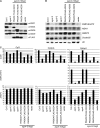The Arabidopsis RNA-directed DNA methylation argonautes functionally diverge based on their expression and interaction with target loci
- PMID: 20173091
- PMCID: PMC2845420
- DOI: 10.1105/tpc.109.072199
The Arabidopsis RNA-directed DNA methylation argonautes functionally diverge based on their expression and interaction with target loci
Abstract
Argonaute (AGO) effectors of RNA silencing bind small RNA (sRNA) molecules and mediate mRNA cleavage, translational repression, or epigenetic DNA modification. In many organisms, these targeting mechanisms are devolved to different products of AGO multigene families. To investigate the basis of AGO functional diversification, we characterized three closely related Arabidopsis thaliana AGOs (AGO4, AGO6, and AGO9) implicated in RNA-directed DNA methylation. All three AGOs bound 5' adenosine 24-nucleotide sRNAs, but each exhibited different preferences for sRNAs from different heterochromatin-associated loci. This difference was reduced when AGO6 and AGO9 were expressed from the AGO4 promoter, indicating that the functional diversification was partially due to differential expression of the corresponding genes. However, the AGO4-directed pattern of sRNA accumulation and DNA methylation was not fully recapitulated with AGO6 or AGO9 expressed from the AGO4 promoter. Here, we show that sRNA length and 5' nucleotide do not account for the observed functional diversification of these AGOs. Instead, the selectivity of sRNA binding is determined by the coincident expression of the AGO and sRNA-generating loci, and epigenetic modification is influenced by interactions between the AGO protein and the different target loci. These findings highlight the importance of tissue specificity and AGO-associated proteins in influencing epigenetic modifications.
Figures






Comment in
-
Differentiation among the ARGONAUTES.Plant Cell. 2010 Feb;22(2):294. doi: 10.1105/tpc.110.220211. Epub 2010 Feb 19. Plant Cell. 2010. PMID: 20173090 Free PMC article. No abstract available.
References
-
- Baumberger N., Tsai C.-H., Lie M., Havecker E., Ziegler-Graff V., Baulcombe D.C. (2007). The polerovirus silencing suppressor P0 targets ARGONAUTE proteins for degradation. Curr. Biol. 17: 1609–1614 - PubMed
-
- Brennecke J., Aravin A.A., Stark A., Dus M., Kellis M., Sachidanandam R., Hannon G.J. (2007). Discrete small RNA-generating loci as master regulators of transposon activity in Drosophila. Cell 128: 1089–1103 - PubMed
-
- Brodersen P., Voinnet O. (2006). The diversity of RNA silencing pathways in plants. Trends Genet. 22: 268–280 - PubMed
Publication types
MeSH terms
Substances
Associated data
- Actions
- Actions
- Actions
- Actions
- Actions
- Actions
- Actions
- Actions
- Actions
- Actions
- Actions
- Actions
- Actions
- Actions
- Actions
- Actions
- Actions
- Actions
- Actions
- Actions

